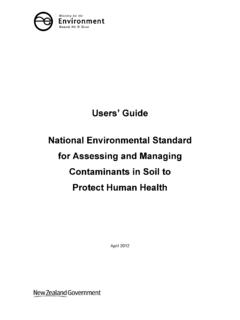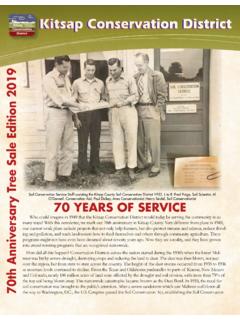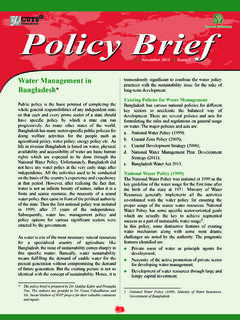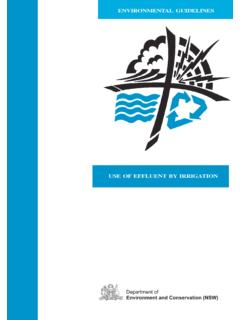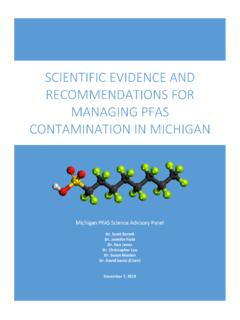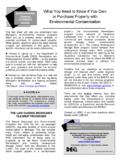Transcription of Risk Assessment for Contaminated Sites in Europe
1 Risk Assessment for Contaminated Sites in Europe CARACAS. Concerted Action on Risk Assessment for Contaminated Sites in the European Union 1996 1998. This Concerted Action programme was funded by the European Commission under the Environment and Climate Programme, and coordinated by the German Umweltbundesamt. Contributors to the programme are listed below. Project Coordination: Dr Volker FRANZIUS, Harald KASAMAS. Austria: Mag. Nora AUER, Martin SCHAMANN Dr Andreas P. LOIBNER. Belgium: Mr Eddy VAN DYCK, Ir Christa CORNELIKS. Denmark: Mrs Irene EDELGAARD Dr Bjorn Kaare JENSEN Dr John JENSEN. Finland: Mr Ari SEPP NEN Dr Timo ASSMUTH Prof. Dr Terttu VARTIAINEN. France: Mr Bruno SAUVALLE Ms Denise ESCULPAVIT Dr Dominique DARMENDRAIL Dr Patrick CHARBONNIER Ms Nathalie GONTHIEZ. Germany: Mr Andreas BIEBER Dr Hans-Joachim STIETZEL Dr Karin FREIER.
2 Greece: Dr Aristotelis ISAAKIDIS Fotini BOURA Dr Alexandros LIAKOPOULOS. Ireland: Dr Brian LEECH Dr Ted NEALON Mr Gerry CARTY Dr Matthew CROWE. Italy: Mr Giovanni BRUNELLI Dr Francesca QUERCIA Prof. Luciano MORSELLI. The Netherlands: Dr DENNEMAN Dr Frank A. SWARTJES Dr Joop J. VEGTER. Norway: Mr Harald SOLBERG Dr Eilen Arctander VIK. Portugal: Mrs Ana LIMA Dr Celeste JORGE Prof. Dr Eduardo Anselmo FERREIRA DA SILVA. Spain: Dr Jos L PEZ de VELASCO Dr Arantzazu URZELAI Mr Juan GRIMA OLMEDA. Sweden: Ms Fredrika NORMAN Dr Lennart DOCK Prof. Dr Dag BROMAN. Switzerland: Dr Christopher WENGER Mr Michael JAGGY Dr Kristin BECKER VAN SLOOTEN. United Kingdom: Prof. Judith DENNER Dr Valerie FORSTER Prof. Dr Colin FERGUSON Mrs Sue HERBERT. Editorial Board for this book Prof. Colin Ferguson (Chairman) Dr Dominique Darmendrail Dr Karin Freier Dr Bjorn Kaare Jensen Dr John Jensen.
3 Harald Kasamas Dr Arantzazu Urzelai Dr Joop Vegter Risk Assessment for Contaminated Sites in Europe Volume 1 Scientific Basis A report prepared as part of the Concerted Action on Risk Assessment for Contaminated Sites in the European Union (CARACAS). This programme was funded by the European Commission under the Environment and Climate Programme, and coordinated by the German Umweltbundesamt. LQM Press Nottingham LQM Press, a division of Land Quality Management Ltd, 1998. LQM Press PO Box 5095. Nottingham NG2 6FB. UK. Tel. (national) 0115 xxx xxxx Tel. (international) +44 115 xxx xxxx Email for orders: xxxxxxxxx@xxxxx All Rights Reserved. No part of this book may be reproduced, stored in a retrieval system, or transmitted, in any form or by any means, electronic, mechanical, photocopying, recording or otherwise, except under the terms of the Copyright, Designs and Patents Act 1998 or under the terms of a licence issued by the Copyright Licensing Agency Ltd, 90 Tottenham Court Road, London W1P 9HE, UK, without the permission in writing of the publisher.
4 First printed 1998. ISBN O .. British Library Cataloguing-in-Publication Data A catalogue record for this book is available from the British Library. It is recommended that reference to this book be made in the following way: Ferguson, C., Darmendrail, D., Freier, K., Jensen, , Jensen, J., Kasamas, H., Urzelai, A. and Vegter, J. (editors) 1998 Risk Assessment for Contaminated Sites in Europe . Volume 1. Scientific Basis. LQM. Press, Nottingham. Typeset from authors' discs by Bywater Typesetting. Printed and bound by . This book is printed on acid-free paper responsibly manufactured from sustainable forestation, for which at least two trees are planted for each one used for paper production. Contents Foreword 1 General introduction 1. Background to this book 1. Outline of chapter contents 2. 2 Fundamental concepts of risk Assessment 7.
5 Introduction 7. The origin of risk Assessment 7. The concept of risk 8. Various types of risk Assessment 9. Current practice 10. A framework for Contaminated land risk Assessment 10. Current use of risk Assessment 13. Priority setting and derivation of remediation goals 14. Generic criteria versus site-specific risk Assessment 15. General methodological aspects 17. Risk Assessment and the management of uncertainties 17. The perception of risk 18. Risk Assessment and risk management 20. Concluding remarks 21. 3 Receptors: human health 25. Introduction 25. Criteria for selecting priority substances 26. Criteria for selecting appropriate toxicological and epidemiological studies 26. Interpretation of toxicity data 28. Use of animal studies 28. Carcinogenic substances 30. Application of results 32. Bioavailability 32. Routes of entry 33.
6 Exposure to chemical mixtures 34. Exposure from multiple sources 36. Summary and conclusions 37. 4 Receptors: ecosystem health 41. Introduction 41. Ecological screening and guideline values 43. General approach 43. v Derivation of soil screening values 44. Ecotoxicological test systems for establishing generic SSVs 47. Biological assays 51. Introduction 51. Bioassays using microorganisms 52. Bioassays with plants 53. Bioassays with soil fauna 53. Potential approaches for future application 54. Concluding remarks 58. 5 Site and source characterisation 69. Introduction 69. Current practice 71. Data needs for risk Assessment 72. Strategies for data collection 73. Methodologies for data collection 75. Data quality and uncertainties 76. Concluding remarks 78. 6 Pathways: transport and fate of contaminants 79. Introduction 79. Transport and fate in groundwater 83.
7 Solute transport 83. Dispersion 84. Solubilisation 85. Sorption/desorption 85. Complexation 86. Precipitation 86. Biological processes 87. Transport from soil to surface waters 88. Transport and fate in air 89. Transport via dust 89. Transport via vapour 90. Transport via plant uptake 92. Metals 92. Organic contaminants 93. Transport via direct contact 94. Direct ingestion of soil 94. Ingestion of soil attached to vegetables 95. Dermal exposure 96. Summary and conclusions 96. Contaminant hydrogeology 96. Exposure via inhalation and ingestion 99. 7 Models 103. Introduction 103. Current practice 104. Priority setting models 105. vi Contents Transport from soil models 106. Groundwater models 107. Human exposure models 108. Receptor groups 109. Exposure scenarios 112. Results of the exposure Assessment 112. Toxicological models 112. Ecotoxicological models 113.
8 Uncertainties and probabilistic approaches 114. Summary and conclusions 115. 8 Screening and guideline values 121. Introduction 121. Different roles of screening/guideline values 124. (a) Values applied in the prevention of new soil contamination 124. (b) Values applied in the management of already Contaminated Sites 125. Current practice 126. Approaches in the use of screening/guideline values 126. Differences between countries 127. Policy issues 131. Concluding remarks 133. 9 Better methods for risk Assessment 135. Scientific and research needs 135. The nature of Contaminated land 136. Fitness for use 140. Risk comparison 141. Other needs 144. Index 147. vii viii Foreword The pollution of soil and groundwater caused by abandoned waste disposal Sites and Contaminated industrial areas is a complex environmental problem in all industrialised countries.
9 Within the European Union, several Member States have developed or are currently developing frameworks and procedures for assessing and managing the risks posed by Contaminated Sites . In order to coordinate and concentrate these efforts and to support scientific cooperation between European countries, CARACAS, the Concerted Action on Risk Assessment for Contaminated Sites , was initiated. CARACAS, which started in February 1996, is funded by the EC. Environment and Climate R&D Programme in order to tackle the problem of Contaminated land. It was initiated by the German Federal Ministry for the Environment and coordinated by the Federal Environmental Agency. It brings together the combined knowledge of academics and government experts from 16 European countries. The CARACAS work focuses on the coordination of current research initiatives on Contaminated land risk Assessment in Europe , and on the definition of scientific priorities for future R&D programmes in order to improve the scientific basis for assessing risks from Contaminated Sites .
10 During the course of CARACAS a fruitful cooperation between scientists, representatives of the participating countries and the European Commission, and various national and international initiatives has been developed. This book is one of the major outputs from this scientific partnership. It summarises the conclusions and recommendations drawn by CARACAS scientists for various research areas related to risk Assessment of Contaminated land. It is a unique reference for the practical state-of-the-art on risk Assessment in Europe , and explains perceived research needs in the context of current approaches for Contaminated land risk Assessment in European countries. Acknowledgements The scientific guidance of the editorial board and the CARACAS. working groups is gratefully acknowledged. Special thanks are due to Prof. Colin Ferguson and Dr Joop Vegter for the final editing and to Harald Kasamas for coordinating the various contributions to this publication.
